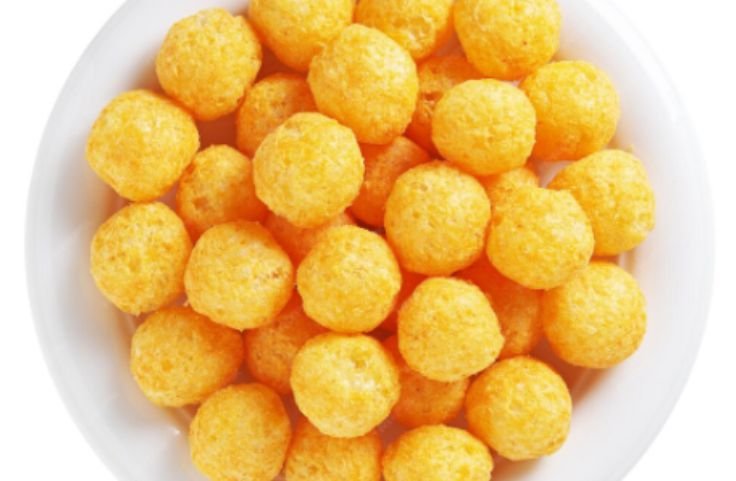Tapioca cheese balls are crispy on the outside, gooey on the inside, and packed with cheesy goodness. A perfect gluten-free snack that’s easy to love and hard to resist.
Tapioca cheese balls speak to your craving for something simple yet satisfying.
You bite into that golden shell and get a warm, stretchy burst of cheese with just the right amount of chew.
You don’t need fancy ingredients or a long prep time. With tapioca starch and cheese, you create a snack that feels familiar yet exciting.
What makes them even better is their gluten-free nature, giving more people a reason to enjoy every bite without worry.
Whether you bake or fry them, they remain crisp on the outside and soft on the inside.
From casual snacking to weekend get-togethers, these little balls fit right in. You can mix in herbs, spices, or even local cheeses to match your taste.
If you’ve never made them before, this is your moment to turn simple ingredients into something you’ll want again.
New to tapioca? Start with this comprehensive overview.
Table of Contents
- What Are Tapioca Cheese Balls?
- Are Tapioca Cheese Balls the Same as Pão de Queijo?
- Ingredients for Tapioca Cheese Balls
- How to Make Tapioca Cheese Balls
- Texture and Flavor Profile
- Recipe Variations for Tapioca Cheese Balls
- Serving Ideas for Tapioca Cheese Balls
- Tapioca Starch vs Cassava Flour in Cheese Balls
- Storage and Reheating Tips
- Conclusion
- Frequently Asked Questions
What Are Tapioca Cheese Balls?
Tapioca cheese balls are bite-sized snacks made with tapioca starch and cheese, offering a crisp outside and chewy, cheesy center.
Naturally gluten-free, they’re a favorite among those avoiding wheat.
The tapioca starch gives them a chewy texture that sets them apart from regular flour-based snacks, while the cheese adds savory depth.
In Brazil, they’re known as pão de queijo, and in parts of Asia, they’re served with local twists.
You can season them with herbs or spices, or switch up the cheese to suit your taste.
Whether you’re serving them as appetizers, snacks, or sides, they fit just about any occasion.
From street food stalls to home kitchens, tapioca cheese balls continue to win hearts with their flavor, texture, and flexibility across cultures and diets.
Are Tapioca Cheese Balls the Same as Pão de Queijo?
Tapioca cheese balls and Pão de Queijo are essentially the same, especially in how they’re made and what they taste like.
Pão de Queijo is the Brazilian name for these chewy, cheesy snacks made with tapioca starch and cheese.
The term “tapioca cheese balls” is often used outside Brazil to describe the same treat in a more general way.
Both are naturally gluten-free and share that stretchy, airy texture thanks to tapioca starch.
Traditional Pão de Queijo usually uses Minas cheese, but mozzarella, parmesan, or cheddar can be substituted, especially in homemade versions.
While some recipes vary slightly across cultures, the idea remains the same: a baked ball with a crisp shell and a soft, cheesy inside.
So, whether you call them tapioca cheese balls or Pão de Queijo, you’re enjoying the same delicious bite.
Ingredients for Tapioca Cheese Balls
Tapioca cheese balls mix creamy cheese and chewy starch in every bite. To get the texture right and the flavor spot on, you need the right ingredients and a few smart choices.
Tapioca Starch: Your Chewy Base
You need tapioca starch, not cassava flour, for that stretchy, chewy bite.
Tapioca starch is extracted from the root’s pulp and feels powdery.
Cassava flour includes the whole root and behaves differently.
Using the wrong one will give you a crumbly result, not the smooth chew you’re looking for.
Cheese: The Flavor Punch
Go for a mix of parmesan and mozzarella. Parmesan gives you a sharp, nutty hit while mozzarella melts into a creamy texture.
Together, they keep the balls soft inside and golden outside. You get structure, flavor, and that perfect pull when you break one open.
Liquid: What Binds It All
Add milk, water, or oil, just enough to hold the dough together. Milk adds richness, water keeps it neutral, and oil gives it a slight crisp.
Whatever you choose, your goal is a smooth, pliable dough that doesn’t fall apart when rolled.
Eggs: For Shape and Structure
Eggs make the dough hold its shape. Without them, your balls might crack or flatten during baking.
They also help the cheese and starch stick together. Use one or two depending on how much dough you’re working with.
Seasonings: Add Your Style
Add garlic powder, herbs, or chili flakes to suit your taste. This is where you make the recipe your own.
Want it classic? Stick to salt and pepper. Want a kick? Add smoked paprika or cumin. The flavor is in your hands.
Related Posts
The Brazilian Tapioca Crepe and How to Make It
How to Use Tapioca Starch as a Thickener
Popular Snacks Made from Tapioca
Tapioca Starch vs Tapioca Flour
Tapioca What is it Made From and Made of?
How to Make Tapioca Cheese Balls
You’re just a few steps away from chewy, cheesy snacks that work for any gathering.
Making tapioca cheese balls takes little effort, but every step matters for the perfect bite.
Boil Water: Start the Dough Right
Bring water to a boil. Pour it slowly into a bowl filled with tapioca starch. Mix immediately.
This heat softens the starch and starts forming that signature stretchy dough. If you wait too long, the mixture stiffens and won’t combine properly.
Mix: Get the Right Texture
Stir the hot water and tapioca starch until smooth. You want a soft, elastic dough with no dry pockets. If it looks lumpy or gritty, keep mixing.
The texture should be silky, not runny or stiff.
Cool: Make It Easy to Handle
Let the dough rest for a few minutes. This makes it easier to work with. If it’s too hot, the eggs might scramble when added. Slightly warm is perfect for the next step.
Add Eggs: Bind It Together
Crack your eggs and mix well. They help hold the dough and improve the final texture. Use clean hands or a spoon to combine until you get a smooth, unified mix.
Fold in Cheese: Flavor and Stretch
Add shredded or cubed cheese into the dough. Mix until evenly distributed.
As it bakes, the cheese melts inside, creating that rich, chewy bite. Don’t skip this, it’s where the magic happens.
Shape: Roll Into Balls
Scoop and roll the dough into small balls, about the size of marbles. Keep them even so they cook at the same rate. If the dough sticks, wet your hands slightly.
Bake or Air Fry: Choose Your Finish
Preheat your oven or air fryer to 375°F. For baking, line a tray and bake for 15 to 20 minutes until golden.
For air frying, cook for 10 to 12 minutes, shaking halfway.
Related: Does Tapioca Have Gluten?
Texture and Flavor Profile
Tapioca cheese balls stand out for their contrast in texture, a crispy outer shell gives way to a chewy, stretchy center that keeps each bite satisfying.
This combination appeals to anyone who enjoys playful mouthfeel and balanced flavor.
The base taste is mildly cheesy, making it easy to pair with spicy sauces, tangy dips, or even sweet chutneys.
You’re not limited to the classic version, either. Add chili flakes or jalapeños for heat, or stir in herbs and garlic for savory depth.
For a different experience, you can go sweet by mixing in coconut milk or a touch of honey.
Whether you’re serving them as a party starter or snacking solo, they hold their own.
With the right seasoning, you can turn them into something bold, comforting, or completely new, all without changing the base ingredients you already love.
Recipe Variations for Tapioca Cheese Balls
You can do more with tapioca cheese balls than stick to the basics. These easy twists let you play with flavors, textures, and fillings based on your mood or the crowd.
Dairy-Free: Plant-Based and Still Cheesy
If you avoid dairy, you can still enjoy this snack. Use almond, cashew, or coconut-based cheese for creaminess.
Mix with tapioca starch for the familiar chewy bite. A spoonful of nutritional yeast adds a deep, cheesy flavor.
You still get that golden crust and satisfying pull inside without any dairy.
This version works great for vegan diets and keeps the taste rich and satisfying.
Asian-Inspired: Scallions and Sesame
Bring in bold, savory notes by folding chopped scallions into your dough.
Once shaped, bake or fry them as usual. Before serving, sprinkle toasted sesame seeds over the top.
The sharp bite of scallions and the nutty crunch of sesame take the flavor in a whole new direction.
It’s a simple upgrade that adds texture, aroma, and an unmistakable Asian flavor profile to your cheese balls.
Sweet Version: Coconut and Creamy Cheese
You can turn this snack into a dessert with coconut milk and mild cheese.
Mix the two into your dough for a lightly sweet, creamy flavor.
Before cooking, roll each ball in crushed coconut flakes for a bit of crunch and added sweetness.
This version gives you a golden, crispy outside with a soft, rich center.
It’s perfect when you want something different without changing the process too much.
Stuffed Center: Melty Cheese Surprise
Make things fun by stuffing each ball with a small cube of cheese before rolling.
You’ll get a crispy outside and a gooey, molten center with every bite.
Use mozzarella for that classic stretch or go bold with smoked cheese.
When the cheese melts inside, it turns every bite into a surprise.
This version is great for serving warm and works well as a party snack or appetizer.
Serving Ideas for Tapioca Cheese Balls
You can serve tapioca cheese balls in more ways than you think.
Their chewy texture and cheesy center make them perfect for parties, snacks, or mealtime sides. Just pair them right and present them well.
Serving Ideas for Tapioca Cheese Balls
You can serve tapioca cheese balls in more ways than you think.
Their chewy texture and cheesy center make them perfect for parties, snacks, or mealtime sides. Just pair them right and present them well.
Serve as Party Appetizers with Flavorful Dips
Offer them garlic mayo, spicy ketchup, or avocado dip. Their crispy bite and stretchy center pair well with bold flavors.
Arrange them with toothpicks and small bowls of dip for easy sharing and a party-friendly setup.
Pack Them in Lunchboxes for a Fun Snack
Tapioca cheese balls are lunchbox-friendly, hold their shape, and taste good even cold. Pack them with fruit or a boiled egg.
Their chewy bite offers a fun break from usual snacks for both kids and adults.
Add to Afternoon Tea for a Savory Bite
Serve them warm beside sweet pastries to add a savory option. They balance sugary treats and pair well with black tea or chai.
Their soft inside and crisp shell give tea time a flavorful twist.
Serve as a Side for Family Dinners
Add them to plates with grilled meat, soups, or salads. They won’t overpower the meal but add chew and cheesy depth.
Their mild flavor complements many dishes and turns simple dinners into something more satisfying.
Tapioca Starch vs Cassava Flour in Cheese Balls
To get the texture right in your cheese balls, you need to understand the difference between tapioca starch and cassava flour.
Both come from the same root, but they work very differently.
Tapioca Starch: The Key to Stretch and Chew
Use tapioca starch if you want that stretchy, chewy bite in your cheese balls. It’s made by extracting the starch from the cassava root, so it’s smooth and powdery.
When mixed with hot liquid, it forms a dough that holds together and stretches beautifully.
This texture is what makes every bite so satisfying. If your dough feels too loose, it usually means the starch wasn’t fully hydrated during mixing.
Cassava Flour: Dense and Doughy, Not Stretchy
Cassava flour might sound similar, but it behaves differently. It’s made from the whole cassava root, so it still has fiber and a slightly gritty feel.
In cheese balls, this makes the texture dense and bread-like instead of chewy.
The dough won’t stretch or bind the same way. You’ll end up with a snack that feels more like a soft biscuit, not the chewy center you expect from a proper tapioca cheese ball.
Why the Right One Matters for Cheese Balls
Using the wrong flour changes everything. Tapioca starch gives you the texture you’re aiming for: chewy, stretchy, and just firm enough to hold shape.
Cassava flour, on the other hand, makes them too thick and heavy.
If you want your cheese balls to puff, pull, and please, don’t swap one for the other.
Stick with tapioca starch for results that feel right and taste like the ones you’ve had before.
Storage and Reheating Tips
Tapioca cheese balls taste best fresh, but you can still enjoy them later with the right storage.
Once they’ve cooled, store them in an airtight container in the fridge for up to three days.
For longer storage, freeze the raw dough balls by placing them on a tray, letting them firm up, then transferring them to a freezer-safe container.
You can bake them straight from frozen, just give them extra time in the oven.
To reheat cooked cheese balls, skip the microwave. Use an oven or air fryer set to 350°F.
In the oven, heat them for 10 to 15 minutes. In the air fryer, 6 to 8 minutes works well.
Both options help bring back that crisp outside and chewy center you love. Store smart, reheat right, and you’re always snack-ready.
Conclusion
Tapioca cheese balls are more than just a snack; they’re a fun, satisfying bite with universal appeal.
Crisp on the outside and gooey inside, they check all the boxes: easy to make, endlessly customizable, and naturally gluten-free.
From party platters to lunchboxes and everything in between, they fit right into your day without fuss.
Stick to tapioca starch for that perfect chewy pull, and don’t be afraid to mix in herbs, spices, or different cheeses.
You can even make dairy-free or stuffed versions depending on your mood.
Bake them, fry them, freeze them, these little bites always come back crispy and warm.
Once you’ve had your first homemade batch, you’ll keep coming back for more. Try them once and they’ll earn a regular spot in your kitchen.
Frequently Asked Questions
Are tapioca cheese balls gluten-free?
Yes. Tapioca cheese balls use tapioca starch, which contains no gluten, making them a safe and tasty option for gluten-sensitive or celiac-friendly diets.
Can you make tapioca cheese balls without eggs?
Yes. Use a flaxseed or chia egg alternative to bind the dough. The texture may vary slightly, but the cheese and starch still create chewiness.
Can you freeze tapioca cheese balls?
Absolutely. Freeze shaped, uncooked balls on a tray, then transfer to a freezer-safe container. Bake straight from frozen with a few extra minutes added.
Why are my tapioca cheese balls too dense?
You likely used cassava flour instead of tapioca starch. Cassava flour is heavier and lacks the elasticity needed for that signature chewy texture.

Chimeremeze Emeh is a writer and researcher passionate about Africa’s most transformative root crop—cassava. Through his work at cassavavaluechain.com, he explores the entire cassava industry, from cultivation and processing to its diverse applications in food, health, and industrial use.
He also writes for palmoilpalm.com, where he shares his extensive experience and deep-rooted knowledge of palm oil, covering red palm oil, palm kernel oil, and refined products. His work there reflects his lifelong connection to agriculture and his commitment to promoting sustainable value chains in Africa.
Driven by curiosity and purpose, Chimeremeze aims to shed light on how cassava continues to empower communities, strengthen food systems, and link traditional farming wisdom with modern innovation.

